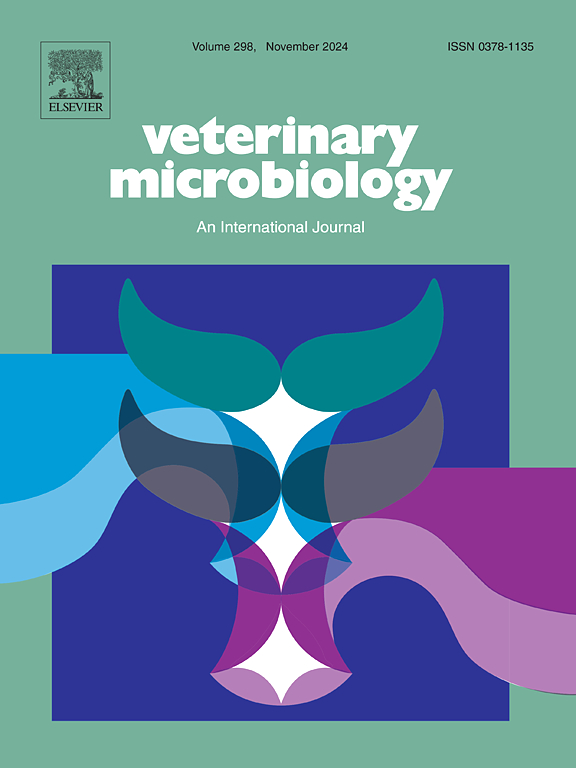欧洲褐兔(Lepus europaeus) Lagovirus疾病动力学的病理和血清学见解:一项为期9年的纵向研究
IF 2.4
2区 农林科学
Q3 MICROBIOLOGY
引用次数: 0
摘要
欧洲褐兔综合征病毒(EBHSV;GII.1)和兔出血性疾病病毒2 (RHDV2;GI.2)是影响欧洲褐兔(Lepus europaeus)的致病性lagovirus。EBHSV / GII。1引起周期性流行,而RHDV2/GI。2例感染发生在野兔与欧洲兔(Oryctolagus cuniculus)同乡地区的外溢事件中。在伊比利亚半岛东北部,这些物种的重叠为调查这些病毒的流行病学如何与病程相关提供了独特的机会。我们分析了2015年至2024年间在加泰罗尼亚(西班牙东北部)回收的113具欧洲棕色野兔尸体中lagovirus的存在。对动物进行尸检,采集组织和血清标本进行组织病理学、病毒学和血清学检查。明显健康的被猎杀野兔的血清(n = 89,2015-2023)也被纳入研究。肝标本PCR (n = 58)和阳性血清病毒学ELISA (n = 52)证实28例EBHSV/GII。1和24 RHDV2/GI。2例。在第一次EBHSV/GII之后。在2016年1次检测中,抗体滴度逐渐下降,直到2020-2021年,与疫情同时发生。RHDV2/GI无结论性血清阳性。研究期间观察到2例。病理显示RHDV2/GI多发急性病变。与EBHSV/ gii相比,2只野兔感染。这些因免疫反应不足而导致猝死的病变可能解释了这种独特的流行病学情况。尽管RHDV2/GI已经流行了十年。我还没有完全适应野兔。然而,持续监测至关重要,因为突变或重组事件可能增加其流行潜力。这两种潟湖病毒的共同循环,加上其他辅助因素,可能会危及欧洲棕色野兔种群在其活动范围的南部极限的生存能力。本文章由计算机程序翻译,如有差异,请以英文原文为准。
Pathological and serological insights into Lagovirus diseases dynamics in the European brown hare (Lepus europaeus): A nine-year longitudinal study
The European brown hare syndrome virus (EBHSV; GII.1) and rabbit haemorrhagic disease virus 2 (RHDV2; GI.2) are pathogenic lagoviruses affecting the European brown hare (Lepus europaeus). EBHSV/GII.1 causes periodic epidemics, while RHDV2/GI.2 infections emerge from spillover events in areas where hares are sympatric with European rabbits (Oryctolagus cuniculus). In the northeast of the Iberian Peninsula, the overlap of these species provides a unique opportunity to investigate how the epidemiology of these viruses correlates with disease course. We analysed the presence of lagoviruses in 113 European brown hare carcasses recovered in Catalonia (NE Spain) between 2015 and 2024. Animals were necropsied, and tissue and serum samples were collected for histopathology, virological investigation, and serology. Sera from hunted hares apparently healthy (n = 89, 2015–2023) were also included in the study. PCR on liver samples (n = 58) and virological ELISA on positive sera (n = 52) confirmed 28 EBHSV/GII.1 and 24 RHDV2/GI.2 cases. After the first EBHSV/GII.1 detection in 2016, antibody titres decreased progressively until 2020–2021, coinciding with an outbreak. No conclusive seropositivity for RHDV2/GI.2 was observed during the study. Pathology revealed more acute lesions in RHDV2/GI.2-infected hares compared to EBHSV/GII.1. These lesions, resulting in sudden death due to a deficient immune response, may explain this distinct epidemiological scenario. Despite a decade of circulation, RHDV2/GI.2 has not fully adapted to hares. However, ongoing monitoring is essential, as mutations or recombination events could increase its epizootic potential. The co-circulation of both lagoviruses, combined with other co-factors, might jeopardise the viability of European brown hare populations at the southern limit of their range.
求助全文
通过发布文献求助,成功后即可免费获取论文全文。
去求助
来源期刊

Veterinary microbiology
农林科学-兽医学
CiteScore
5.90
自引率
6.10%
发文量
221
审稿时长
52 days
期刊介绍:
Veterinary Microbiology is concerned with microbial (bacterial, fungal, viral) diseases of domesticated vertebrate animals (livestock, companion animals, fur-bearing animals, game, poultry, fish) that supply food, other useful products or companionship. In addition, Microbial diseases of wild animals living in captivity, or as members of the feral fauna will also be considered if the infections are of interest because of their interrelation with humans (zoonoses) and/or domestic animals. Studies of antimicrobial resistance are also included, provided that the results represent a substantial advance in knowledge. Authors are strongly encouraged to read - prior to submission - the Editorials (''Scope or cope'' and ''Scope or cope II'') published previously in the journal. The Editors reserve the right to suggest submission to another journal for those papers which they feel would be more appropriate for consideration by that journal.
Original research papers of high quality and novelty on aspects of control, host response, molecular biology, pathogenesis, prevention, and treatment of microbial diseases of animals are published. Papers dealing primarily with immunology, epidemiology, molecular biology and antiviral or microbial agents will only be considered if they demonstrate a clear impact on a disease. Papers focusing solely on diagnostic techniques (such as another PCR protocol or ELISA) will not be published - focus should be on a microorganism and not on a particular technique. Papers only reporting microbial sequences, transcriptomics data, or proteomics data will not be considered unless the results represent a substantial advance in knowledge.
Drug trial papers will be considered if they have general application or significance. Papers on the identification of microorganisms will also be considered, but detailed taxonomic studies do not fall within the scope of the journal. Case reports will not be published, unless they have general application or contain novel aspects. Papers of geographically limited interest, which repeat what had been established elsewhere will not be considered. The readership of the journal is global.
 求助内容:
求助内容: 应助结果提醒方式:
应助结果提醒方式:


